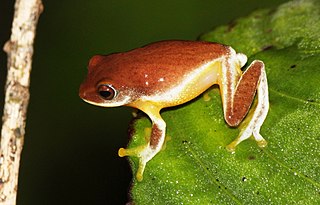The Honduran brook frog is a species of frog in the family Hylidae endemic to Honduras. Its natural habitats are subtropical or tropical moist lowland forests, subtropical or tropical moist montane forests, and rivers. Scientists have seen it between 90 and 1400 m above sea level in Honduras in rainforests.
The Rio Chingual Valley tree frog is a species of frog in the family Hylidae found in Colombia and Ecuador. Its natural habitats are subtropical or tropical moist montane forests, rivers, and heavily degraded former forests. Scientists have seen it between 1950 and 2700 meters above sea level.
The Papallacta tree frog is a species of frog in the family Hylidae found in Colombia and Ecuador. Its natural habitats are subtropical or tropical moist montane forests and rivers. Scientists have seen it between 1950 and 2660 meters above sea level in the Cordillera Oriental. It is threatened by habitat loss.
The Pilalo tree frog is a species of frog in the family Hylidae endemic to Ecuador. Its natural habitats are subtropical or tropical moist montane forests and rivers. It has been observed between 2300 and 2600 meters above sea level. It is threatened by habitat loss.

Scinax boulengeri is a species of frog in the family Hylidae. It is found in Colombia, Costa Rica, Nicaragua, Panama, and possibly Honduras. Its natural habitats are subtropical or tropical moist lowland forests, intermittent freshwater marshes, pastureland, plantations, rural gardens, and urban areas. It has been found as high as 600 meters above sea level.
Cornufer browni is a species of frog in the family Ceratobatrachidae. It is endemic to Papua New Guinea. It has been observed between 100 and 200 meters above sea level and between 1100 and 1300 meters above sea level.

Platymantis guentheri is a species of frog in the family Ceratobatrachidae. It is endemic to the Philippines, where it occurs in the rainforests of Leyte, Biliran, Maripipi, Bohol, Panglao, Dinagat, and Mindanao islands. Its natural habitats are subtropical or tropical moist lowland forest, subtropical or tropical moist montane forest, plantations, rural gardens, and heavily degraded former forest. It has been observed as high as 700 meters above sea level.

Sylvirana faber is a species of frog in the family Ranidae. It is found in Cambodia and possibly Thailand.

Pseudophilautus asankai, commonly called Asanka's shrub frog, is a species of frogs in the family Rhacophoridae.
Philautus cornutus is a species of frog in the family Rhacophoridae. It is endemic to Indonesia. It has been observed 1529 and 1907 meters above sea level.

Pseudophilautus lunatus, commonly known as Handapan Ella shrub frog, is a species of frogs in the family Rhacophoridae.

Pseudophilautus popularis, the common shrub frog, is a species of frogs in the family Rhacophoridae.

Raorchestes anili, known commonly as Anil's bush frog, is a species of frog in the family Rhacophoridae.
Gracixalus quangi is a species of bush frog endemic to Vietnam, Laos, and China, where it has been observed between 550 and 1300 meters above sea level.
Pseudophilautus samarakoon, the Samarakoon's shrub frog, is a species of frogs in the family Rhacophoridae, endemic to Sri Lanka. Wickramasinghe et al. suggest that, following the IUCN Red List criteria, it should be considered "critically endangered" because the extent of occurrence is <100 km2, it is recorded from a single location, and its habitat is under severe threat.
Pseudophilautus schneideri is a species of frogs in the family Rhacophoridae, endemic to Sri Lanka. People have seen it in only a few places: Kudawa, Pituwela, and Kanneliya. People have seen it between 1100 and 1400 meters above sea level.
Tepuihyla shushupe is a frog in the family Hylidae. Scientists know it exclusively from its site of collection, the headwaters of the rivers Ere and Campuya near the Colombian border within Peru. They collected the sample 145 meters above sea level.
The Mixteca cloud-forest tree frog is a frog in the family Hylidae. It is endemic to Mexico. Scientists know it exclusively from the type locality: 1390 meters above sea level in the western Sierra Madre del Sur, in Oaxaca.
The tepui tree frog is a frog in the family Hylidae, endemic to Brazil and Venezuela. Scientists have seen it between 420 and 1800 meters above sea level.
Leptomantis malkmusi is a species of frog in the family Rhacophoridae. It is endemic to Malaysia, where it has been observed between 500 and 1000 meters above sea level.







